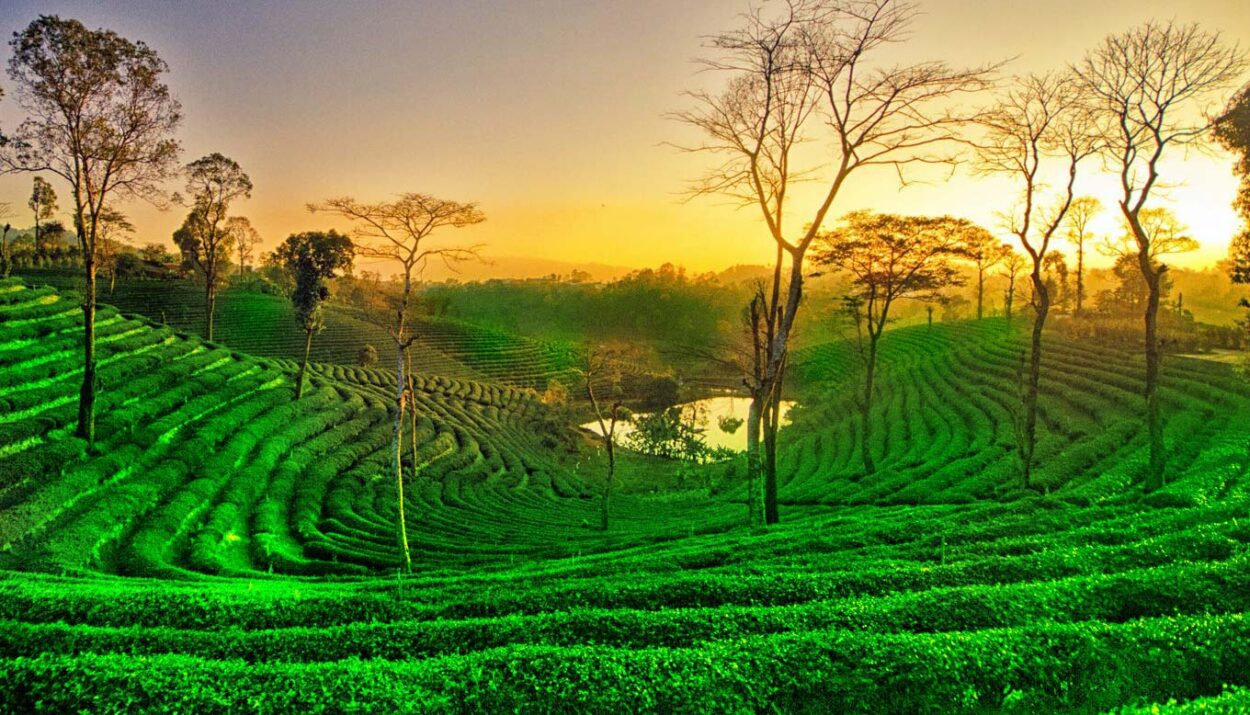Assam cuisine is a vibrant tapestry woven from the rich cultural heritage and diverse ethnic backgrounds of the region. Nestled in the northeastern part of India, Assam is not only known for its lush landscapes and biodiversity but also for its unique culinary traditions that reflect the lifestyle and agricultural practices of its people. The cuisine is characterized by its simplicity, use of fresh ingredients, and a deep connection to nature, which is evident in the way food is prepared and consumed.
Unlike many other Indian cuisines that are often laden with heavy spices, Assamese food tends to be more subtle, allowing the natural flavors of the ingredients to shine through. The culinary practices in Assam are influenced by various factors, including the state’s indigenous tribes, historical trade routes, and the availability of local produce. Rice is the staple food, accompanied by a variety of fish, meat, and vegetables.
The Assamese people have a profound respect for their food, often considering it a reflection of their identity and culture. This reverence is evident in traditional cooking methods that have been passed down through generations, emphasizing the importance of community and family in the culinary experience. As one delves deeper into Assam’s cuisine, it becomes clear that each dish tells a story, revealing the region’s history, geography, and the harmonious relationship between its people and the land.
Key Takeaways
- Assam cuisine is known for its unique flavors and use of indigenous ingredients and spices.
- Traditional Assamese dishes like Aloo Pitika, Masor Tenga, and Khar reflect the region’s rich culinary heritage.
- Unique ingredients and spices such as bamboo shoots, bhut jolokia, and xaak aru bhaji contribute to the distinct taste of Assamese cuisine.
- Assam’s geography, with its fertile plains and abundant rivers, has a significant influence on the availability of ingredients and the cooking methods used in the region.
- Assam tea, known for its robust flavor and aroma, is a popular beverage and an integral part of Assamese culinary culture.
Traditional Assamese Dishes
Flavors of the Region
One of the most iconic Assamese dishes is “Masor Tenga,” a tangy fish curry made with fresh river fish, tomatoes, and a variety of herbs. This dish exemplifies the Assamese penchant for balancing flavors, with the sourness from the tomatoes complementing the fish beautifully, creating a refreshing and satisfying culinary experience.
Innovative Use of Local Resources
Another staple of Assamese cuisine is “Khar,” a unique dish made with raw papaya, pulses, and an alkaline ingredient derived from the ashes of the “khar” plant. This dish showcases the innovative use of local resources and is distinctive in flavor. Vegetables play a significant role in Assamese cuisine, with dishes like “Aloo Pitika,” a mashed potato preparation mixed with mustard oil, green chilies, and onions, being a common accompaniment to meals.
A Celebration of Simplicity and Tradition
The simplicity of Assamese dishes highlights the region’s cooking philosophy, which emphasizes using minimal ingredients to create maximum flavor. Additionally, “Pitha,” a traditional rice cake often filled with jaggery or sesame seeds, is a beloved snack that reflects the region’s agricultural bounty. These dishes are not merely sustenance; they are an integral part of Assamese culture, often enjoyed during family gatherings and festivals.
Unique Ingredients and Spices
The uniqueness of Assam’s cuisine can be attributed to its distinctive ingredients and spices that are often not found in other Indian culinary traditions. One such ingredient is “Bhoot Jolokia,” also known as ghost pepper, which is one of the hottest chilies in the world. This fiery pepper adds a distinct heat to various dishes while also imparting a unique flavor profile that is characteristic of Assamese cooking.
Another essential ingredient is “Naga salt,” which is made from the ashes of certain plants and adds a unique umami flavor to dishes. In addition to these unique ingredients, Assam’s cuisine also features a variety of herbs and greens that are integral to its flavor palette. “Khar” leaves, for instance, are used in various preparations and are known for their health benefits.
The use of fresh herbs like coriander and mint enhances the freshness of dishes, while traditional spices such as turmeric and cumin provide depth and warmth. The emphasis on using locally sourced ingredients not only supports sustainable practices but also ensures that each meal is imbued with the essence of Assam’s rich biodiversity.
The Influence of Assam’s Geography on its Cuisine
| Geographical Factor | Influence on Cuisine |
|---|---|
| Brahmaputra River | Abundance of freshwater fish in Assamese cuisine |
| Hilly Terrain | Use of bamboo shoots and wild greens in dishes |
| Tropical Climate | Availability of tropical fruits like banana, pineapple, and papaya in recipes |
| Tea Gardens | Integration of tea leaves in traditional Assamese beverages |
Assam’s geography plays a pivotal role in shaping its culinary landscape. The state is blessed with fertile plains, lush hills, and an extensive network of rivers, which provide an abundance of fresh produce and aquatic life. The Brahmaputra River, one of the largest rivers in the world, is particularly significant as it supports a thriving fishing industry that supplies an array of freshwater fish to local markets.
This geographical advantage has led to a cuisine that heavily features fish as a primary source of protein. Moreover, Assam’s climate is conducive to growing a variety of crops, including rice, tea, and various fruits and vegetables. The state’s agricultural practices are deeply intertwined with its culinary traditions; for instance, rice cultivation is not just an economic activity but also a cultural one that influences daily meals and festive occasions.
The seasonal availability of ingredients means that Assamese cuisine is dynamic and ever-evolving, with dishes changing according to what is fresh and in season. This connection between geography and cuisine underscores the importance of sustainability and respect for nature in Assamese food culture.
Assam Tea: A Culinary Delight
Assam tea is perhaps one of the most renowned products to emerge from this region, celebrated globally for its robust flavor and rich aroma. The tea estates in Assam are among the largest in the world, producing black tea that is characterized by its malty taste and bright color. The cultivation of tea has become an integral part of Assam’s identity, influencing not only its economy but also its culinary practices.
Tea is often served as part of hospitality rituals, reflecting the warmth and generosity of Assamese culture. In addition to being enjoyed as a beverage, Assam tea has found its way into various culinary applications. Chefs have begun to experiment with tea-infused dishes, incorporating it into desserts like tea-flavored cakes or using it as a marinade for meats.
The versatility of Assam tea allows it to complement both sweet and savory dishes, enhancing flavors while adding a unique twist to traditional recipes. This innovative approach to using tea in cooking showcases how Assam’s culinary scene continues to evolve while honoring its rich heritage.
Street Food and Snacks in Assam
Traditional Favorites
One such snack is “Pani Puri,” known locally as “Puchka,” which consists of hollow puris filled with spicy tamarind water and various fillings. This dish exemplifies the Assamese love for bold flavors and textures.
Adapted Delights
Another popular street food item is “Chowmein,” which has been adapted from Chinese cuisine but has taken on a distinctly Assamese flair. Vendors often add local vegetables and spices to create a unique version that resonates with local palates.
Satisfying Snacks
Additionally, “Samosas” filled with spiced potatoes or lentils are commonly found at roadside stalls, providing a satisfying snack for those on the go. These street foods not only satisfy hunger but also serve as social experiences where people gather to enjoy food together, fostering community bonds.
Festivals and Food Culture in Assam
Food plays a central role in Assam’s festivals, reflecting the region’s rich cultural heritage and agricultural practices. One of the most significant festivals is Bihu, which marks the Assamese New Year and celebrates the arrival of spring. During this time, families prepare traditional dishes such as “Pitha” made from rice flour and filled with sweet or savory fillings.
These rice cakes are often shared among friends and family as symbols of prosperity and togetherness. Another important festival is Rongali Bihu, where feasting becomes an integral part of the celebrations. Traditional dishes like “Masor Tenga” and various meat preparations are served alongside rice, showcasing the abundance of local produce.
The communal aspect of these feasts highlights how food brings people together during joyous occasions, reinforcing social ties within communities. Festivals in Assam are not just about rituals; they are also about celebrating life through food, music, dance, and shared experiences.
Exploring Assam’s Culinary Tourism Opportunities
As interest in culinary tourism grows globally, Assam presents a wealth of opportunities for travelers seeking authentic gastronomic experiences. Tourists can explore local markets where fresh produce is sold or participate in cooking classes that teach traditional Assamese recipes using locally sourced ingredients. These immersive experiences allow visitors to connect with local chefs and home cooks who share their knowledge about Assamese cuisine.
Additionally, tea tourism has gained traction in Assam due to its world-famous tea estates. Visitors can tour these estates to learn about tea cultivation and processing while enjoying tastings that highlight different varieties of Assam tea. Culinary festivals celebrating local food culture also attract tourists eager to experience traditional dishes prepared by skilled chefs.
By promoting its rich culinary heritage through tourism initiatives, Assam can showcase its unique flavors while supporting local communities economically. In conclusion, Assam’s cuisine is a reflection of its diverse culture, geography, and history. From traditional dishes to innovative uses of local ingredients like tea and spices, every aspect contributes to a rich culinary narrative that continues to evolve while honoring its roots.
As culinary tourism flourishes in this region, there lies an opportunity for both locals and visitors to engage deeply with Assam’s vibrant food culture.
If you are interested in learning more about the artistry and innovation in Assam, you may want to check out this article on a few things about artistry and innovation. This article explores the rich cultural heritage and creative endeavors of the region, shedding light on the unique artistic traditions that have flourished in Assam.








